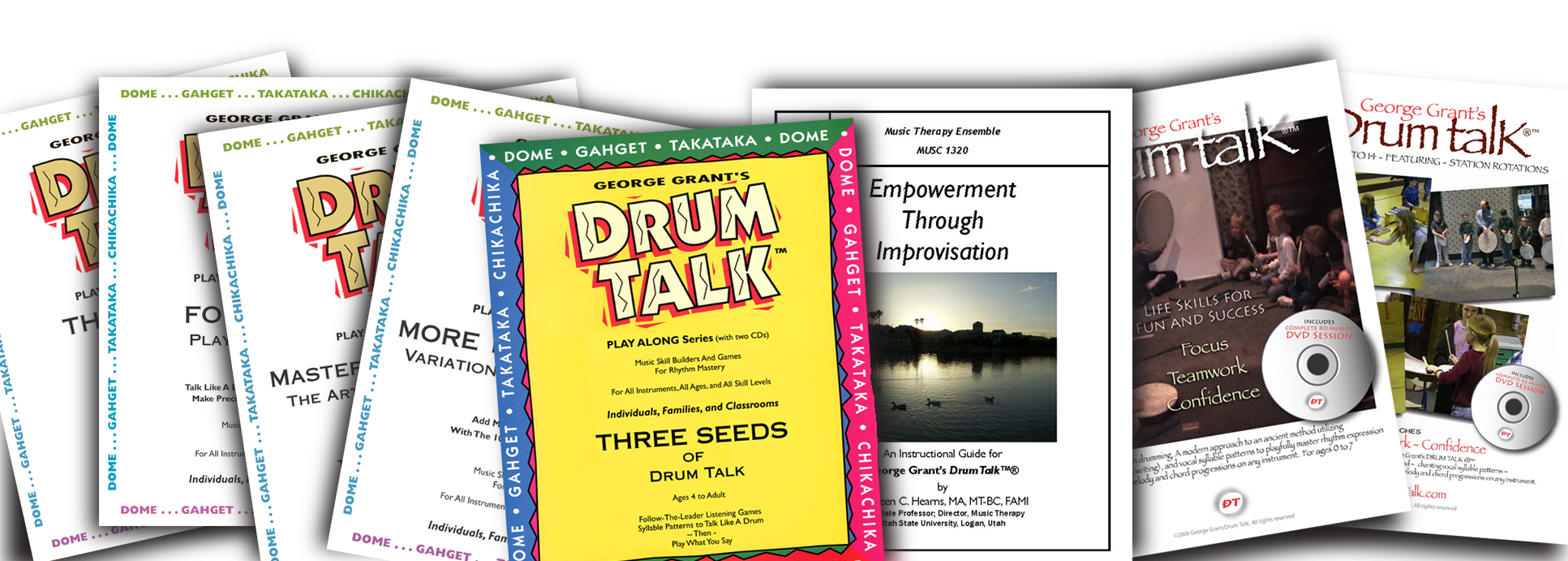

No PayPal? … That’s OK make checks out to:
With your check include your name, items by title and price and your shipping address if appropriate.
Invitation to chat with George — without obligation.
You may have questions so let’s visit, I can learn more about you, answer any questions, and tailor lessons to fit you. Call me at (208) 720-2933 or email me here. If you email please be sure to include your name and phone number.
Music Recordings
None of these recordings fit easily into a simple category. They are all the result of intense creativity, innovation, and people pushing the edges of tradition. These recordings satisfy my decision to choose the path of music as a lifestyle. I am very honored to have been in the presence of so many great souls and amazing creative talents, who refused to stay “inside the box” or to limit their creativity to what was commercially popular.
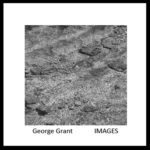
CD – Images
George Grant – Voice, Hand Drums, Percussion
CD – George Grant IMAGES
George Grant – Voice, Hand Drums, Percussion
We read in college course catalogues that “music is created in time and paintings are created in space.” It is not that simple or limited. The laws of physics clearly show that time and space are interdependent and inseparable. And so are music and painting.
In the symmetrical song forms of pop, rock, jazz, and world music, we often feel and perceive the musical groove, making predictable circles, traveling through time in repetitive lengths and consistent speed. Visual music requires more listening skill and imagination. It is easier to see points of tone in different sizes, densities, and shades of light, and then into patterns, when there is no regular speed or no regular length of patterns and symmetry. Without the force of time, the mind can naturally start to see musical imagery. The word imagine means — to see, to visualize — to form an image.
Instead of a spinning wheel of music, one single sound sculpture stands still and floats in space. Now, the mind travels in a circle around the composition, to observe variations and new angles of the completed sculpture.
These selections of experimental sketches from my personal audio journal are not really songs, but more like sound paintings, done with wordless voice techniques and exotic percussion. As deliberate attempts to escape song formulas, rhythm equations, and traditional expectations – these textural experiments are directly inspired by walking slowly out in nature, or standing still in one spot, often with recording gear. Instead of walking with force through the landscape, I move slowly, often off the trail, hunting for surprises. Seeking photos without a camera, I look for visual patterns that cannot be named. Near water and sparse trees is preferred, with plenty of shadow and light — moving water, reflections of water, wading in water, rafting down water, arrangements of rocks and stones and gravel, sand raked by water. Eventually, the outer images trigger my musical thoughts to respond.
These sound sketches are done in the spirit of the haiga painters and haiku poets of Japan, who attempt to capture immediacy and essence of the timeless moment, without filling in all the literal details, without concern for perfect representation.
Music is not given; it is taken. The listener must listen. The listener must imagine and fill in his or her own details.
$16.99
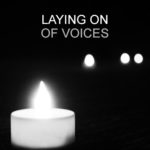
CD – Laying On Of Voices
CD – Laying On Of Voices
These rare documentary recordings are special; like secretly sitting outside under an open window, overhearing a private music ceremony that was never intended to be shared in public, or performed for an audience.
These prayerful music sessions capture the spirit of Freedom Through Vocal Toning, wordless improvised singing with the intention of meditation or prayer, because the music is completely authentic. In these excerpts sung by non-professional singers in George Grant’s classes and workshops, the focused intention was literally, non-verbal prayers, offered for family members with health problems who were not present at the sessions. One session was recorded during a hands-on polarity therapy and cranial sacral session, which included live vocal toning and other sound healing techniques.
Music, especially wordless vocal expression, easily and naturally becomes a form of universal prayer and meditation. This potent energy naturally becomes healing energy.
This gentle reverent music is not entertainment. It is not going to reach out and try to impress you with feats of technical prowess or clever twists and turns. To best listen and absorb these music prayers, it is highly suggested to turn off the phone and lights, sit in a chair or lay down – and do nothing else but listen.
The following comments by Richard Rolle, an English mystic and writer (1300 to 1349), beautifully describe how spontaneous music becomes prayer, and how prayer may become music.
“Whilst I sat in the same chapel in the night, before supper, I sang psalms, as I might, and I heard above me the noise as it were of readers or rather singers. Whilst I took heed, praying to heaven with all desire, in what manner I know not, suddenly I received a most pleasant heavenly melody dwelling within my mind. Indeed, my thought was continuously changed into mirth of song, and I had, as it were, praises in my meditation, and in saying prayers and psalms I gave forth the same sound.”
“Wherefore, too, one who has been made a contemplative man … is perpetually raised to such great joy that he is even permitted to hear the song of the angels. Hence he sings his prayers to God, in a wonderful and indescribable way, because just as now the heavenly sound descends his spirit, so also, ascending in a superabundance of joy to his own mouth, the same sound is heard.”
Richard Rolle (1300-1349)
English Mystic and Writer
$16.99
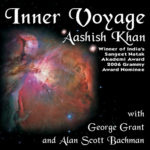
CD – Inner Voyage
CD – Inner Voyage
Inner Voyage features virtuoso Aashish Khan on the 25 string fretless sarode of North India. Grandson of his guru Ustad Allaudin Khan, and son of legendary maestro Ali Akbar Khan, Aashish is the distillation of one of the most illustrious musical families in the history of India. In 2005, Aashish received the highest award given in India to musicians by the Sangeet Natak Akademi.
The music of the Inner Voyage ensemble is described as “a universal sound transcending cultural borders.” The ancient modal melody forms of India are called “raags” (or ragas). In collaboration with keyboard synthesizer artist Alan Bachman and percussionist George Grant, Inner Voyage created a hybrid genre they refer to as “avant raag.” Without compromise, this alternative music maintains the purity of the Indian melody forms, but with non-traditional accompaniment instruments, non-traditional rhythms, and the shorter modern song form. Many people who listen to this recording over and over again, have no previous exposure to traditional classical music of India. Within a tradition of very strict codes of preservation, Aashish, with a little help from his friends, found a way to make this amazing music culture very accessible to the ears and hearts of newcomers. This project proves that music is, in fact, a universal language.
In the words of Rohit Patel, former Trustee at the Ali Akbar College of Music –
“This music appeals to the soul so directly
that it requires no background except the
willingness to submerge into its beauty. It
is fusion at its best”
$16.99
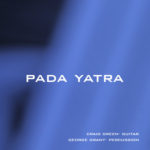
CD – Padayatra Live
Craig Green – Guitar, Oud
George Grant – Tabla, Frame Drums
CD – Padayatra Live
Craig Green – Guitar, Oud
George Grant – Tabla, Frame Drums
A New Orleans native, guitarist Craig Green has scored music for stage, film, ballet and string ensembles. A traveler, he has performed in the US, Canada, Mexico, throughout Europe, and India, always seeking unique collaborations to inspire composition and improvisation. He has worked with serious composers from Cuba and Spain, drummers from India and Brazil, and many famous jazz musicians, singers, and rock bands.
Aside from one-of-kind projects with classical and jazz masters and modern dance companies, George Grant has performed traditional music with virtuosos from every country in the traditional “Silk Route,” including North and South India, Turkey, Iran, Kurdistan, Turkmenistan, Uzbekistan, Afghanistan, and Mongolia.
So is it fate? After decades of traveling all over the globe, immersed in all kinds of jazz and world music, guitarist Craig Green and percussion-chanter George Grant would end up as neighbors in Idaho of all places.
George and Craig easily found their common ground during several concerts providing live accompaniment for painters at the Eagle Rock Art Museum, where this “live” recording was made. To express the spirit of contemporary improvisation inspired by modern jazz and world music, they started to perform as Padayatra, which means “pilgimage” in Vedic Sanskrit.
Each and every performance is a journey based on total freedom and surprise. One “song” often lasts for over twenty minutes. Both always in the lead, and always backing each other up, they both push the limits.
$16.99
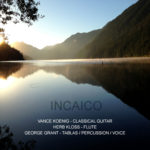
CD – Incaico
Vance Koenig – Classical Guitar
Herb Kloss – Flute
George Grant – Tabla, Percussion, Voice
CD – Incaico
Vance Koenig – Classical Guitar
Herb Kloss – Flute
George Grant – Tabla, Percussion, Voice
A blend of classical, jazz, and world music, Incaico is an elegant recording that appeals to all listening tastes. These recordings began as classical guitar compositions from the high Andes mountains performed by Vance Koenig. www.mauiguitar.com After flutist Herb Kloss and percussionist George Grant finished adding improvised colours, textures, and solos, the resulting music defies limitation to any single genre. It is very accessible, but has depth that sneaks up on the listener.
$16.99
George Grant’s DRUM TALK – Instructional Manuals
Over a decade in the making, this project began at Utah State University in the mid 90’s. The process has been thoroughly field tested several times and the course is taught each year at USU. Maureen Hearns gives Drum Talk presentations around the USA at various Music Therapy Conferences.
Manual will be sent as e-Book. Audio Files will be sent as digital download.
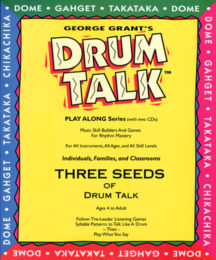
“Three Seeds of Drum Talk”
“Three Seeds of Drum Talk”
George Grant’s Drum Talk Instructional Manual
58 Audio Tracks and 30-Page Manual – Ages 4 to 8
A universal method to prepare to learn any instrument — Drum Talk (DT) begins with a core of 10 “words” and vowel tones. Students follow the leader, echoing or repeating patterns with different combinations of these 10 DT “words,” making only one Steady Beat per “word” with simple percussion instruments. By the end of the program, students easily invent their own creative patterns and are “timed” and grounded in the Steady Beat, ready to learn advanced rhythms in Program 2.
$39.99
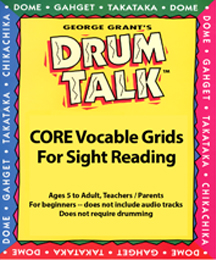
“CORE Vocable Grids for Sight Reading”
George Grant’s DRUM TALK Instruction Manual
32 Page Manual with 28 “Grid” Charts in Large Font
These pre-written “composition” grids serve several purposes. They are often used in conjunction with online instruction with George Grant. The charts start very basic, and gradually add new elements.
Read Grids for: 1) Echo After 4, 2) Repeat A Pattern, or 3) Ostinato Choir: several sections of repeats. One teacher or student leader may read notation for group to hear and response. Or, as “music notation,” entire group may read the grids.
Different grids can be read at the same time by different sections or individuals.
Written grids serve many uses, including leadership, ear training, and multiple choir parts. Learning to read the Drum Talk grids with confidence, leads to free improvisation and composition. After some experience, compose your own grids – eventually 8 beats long and 6 levels high.
Notation includes: Core Drum Talk elements, Foundation elements, pure vowels, open consonants, off-beats, rests, double-vowels, and 8-beat notations
$4.99
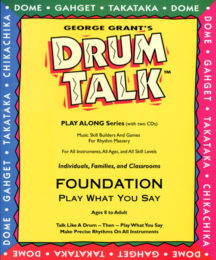
“Foundation Vocal Grids & Play What You Say”
“Foundation Vocable Grids & Play What You Say”
George Grant’s Drum Talk Instructional Manual
18 Audio Tracks and 30-Page Manual – Ages 8 to Adult / Teachers / Parents
Includes IM-4 Empty Framing Patterns
Move at your own pace. This program starts very simple and then slowly adds more advanced vocables to the language of Drum Talk.
Like a skeleton supports the body organs, or the frame of a house supports the walls, furniture and people living inside — the Foundation elements of all rhythm, (including melody and chord progressions) – are based on: Downbeats, Offbeats, and Silent Rests
This is the deep, but simple ecology of music — the hidden DNA code of all rhythm structures. After lots of Play Along, you will you understand — and feel – these simple Foundation patterns. Beginners and intermediate musicians – on all instruments – can really take off and fly with more expressive patterns (programs #3 and #4) – when rhythm Foundation is second nature.
When Foundation patterns are thoroughly understood, it is easier to expand them with many new “words” and elements of the Drum Talk language (included in concluding Grids).
In Three Seeds, you play one Steady Beat for each “element” (DT “word”). In Program 2, you will Play What You Say — striking an instrument on all vocal syllables, to make strong simple patterns.
*** *** *** *** *** *** *** *** *** *** ***
*** *** *** *** *** *** *** *** *** *** ***
$39.99
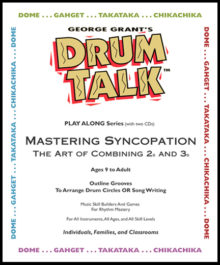
“Mastering Syncopation”
“Mastering Syncopation”
George Grant’s Drum Talk Instructional Manual
21 Audio Tracks and 13-Page Manual – Ages 8 to Adult / Teachers / Parents
Includes IM-4 Empty Framing Patterns
Attention all instrumentalists, music teachers, and singer/song writers!
The simple secrets in this program will prevent years of mystery and confusion. Syncopation – used regularly by drummers, guitarists, pianists, and bassists, and composers – is the heart of all exciting rhythm “weaves.” As one very simple pattern plays in the background — a syncopated rhythm has strong accents on one or more OFF-beats. As well as Drum Talk syllables – this program shows you how to play accents in groups of 2s and 3s – making downbeats and offbeats.
Almost all ensemble problems are rhythm problems. Many musicians who are strong enough to perform in front of others still struggle with syncopation — only because they don’t have a systematic way to train and understand the fundamentals. This program moves slowly and carefully, preparing you carefully for each new step. Move through what you can, then patiently master each step before moving on.
$39.99
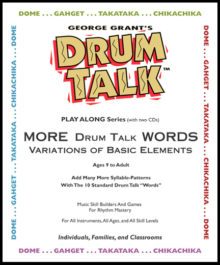
“More Drum Talk Words”
“More Drum Talk Words”
George Grant’s Drum Talk Instructional Manual
Ages 8 to Adult / Teachers / Parents
The Core” Drum Talk words are just the beginning. Dozens of variations and additional syllables are slowly added to expand creative expression. As in the beginning, learn new words slowly, through Pick Quick, Echo After, and Repeat A Pattern audio drills. After some Focus, you will use the new words with increasing Freedom.
*** *** *** *** *** *** *** *** *** *** ***
*** *** *** *** *** *** *** *** *** *** ***
$39.99
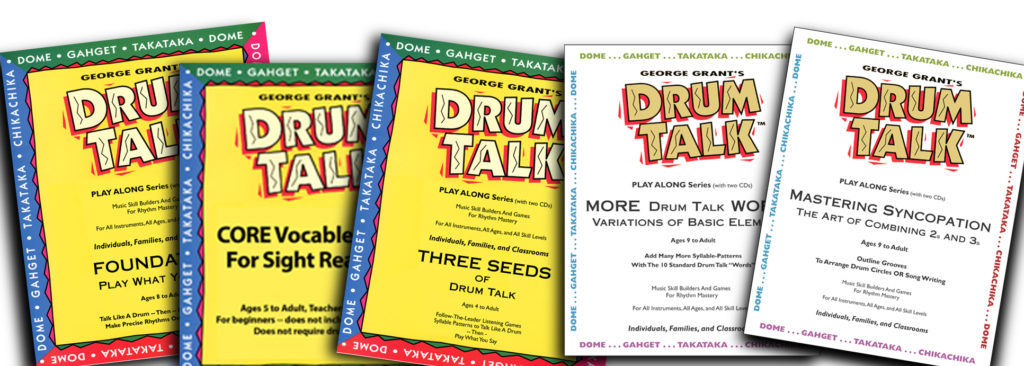
“All Five Drum Talk Manuals Above, Plus All Audio Tracks and Grids for Sight Reading”
$99.99
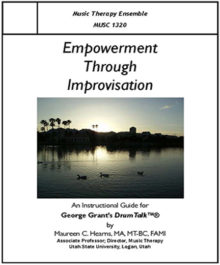
“Empowerment Through Improvisation”
George Grant’s Drum Talk College Curriculum
“Empowerment Through Improvisation”
An Instructional Guide to George Grant’s DRUM TALK
By Maureen Hearns, Professor of Music Therapy
George Grant’s Drum Talk Instructional Manual
220 Page eBook Manual / 92 MP3 Files
Over a decade in the making, this project began at Utah State University in the mid 90’s. The process has been thoroughly field tested several times and the course is taught each year at USU. Maureen Hearns gives Drum Talk presentations around the USA at various Music Therapy Conferences.
Manual will be sent as e-Book. Audio Files will be sent as digital download.
Table of Contents
CHAPTER 1:
“Three Seeds of Drum Talk, Echo After, Repeat A Pattern, Pick Quick”
Chapter 2:
“Focus Then Freedom, Structure and Exploration”
Chapter 3:
“Play What You Say, Interpreting Drum Talk With Universal Hand Drum Techniques”
Chapter 4:
“Empowerment Though Expressive Voice, Embellishing Drum Talk with Pure Vowels and Consonants”
Chapter 5:
“Foundation Elements, Down Beat, Off-Beats, Double Beats, Rests”
CHAPTER 6:
“Standard Accompaniment Patterns And Framing Patterns”
CHAPTER 7:
“Weaving Repeated Patterns, 4’s 8’s 16’s With Drum Talk Grid”
CHAPTER 8:
“Support and Expansion, A-B-C Pyramids”
CHAPTER 9:
“More Drum Talk Words, Variations Of The Ten Core Elements”
CHAPTER 10:
“Mastering Syncopation, The Art of Twos and Threes”
*** *** *** *** *** *** *** *** *** *** ***
*** *** *** *** *** *** *** *** *** *** ***
$34.99
